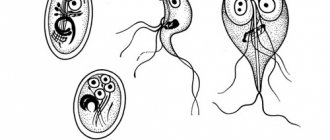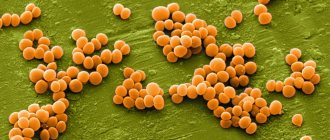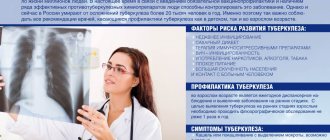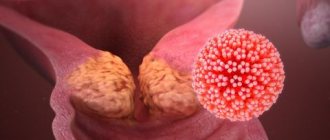Adenoviral infection is a viral disease caused by an adenovirus, one of the types of ARVI. There are a significant number of types of adenoviruses; they are not all well studied, but the role of some of them in the development of pathological conditions in humans is undoubted. Adenoviruses persist outside the body for a long time and withstand low temperatures well. You can get an adenovirus infection at any time of the year; a slight increase in the incidence of this type of ARVI is observed in the autumn-winter period.
Why do adenovirus infections most often affect children?
During the first 6 months of life, children practically do not suffer from adenovirus infection. This is due to the fact that at this age children have passive immunity, inherited from their mother. Then innate immunity is lost, and children begin to get sick.
Adenovirus infection
Until the age of 7 years, a child manages to get sick with adenovirus infection several times. Each time the body develops specific immunity to a specific type of adenovirus, but since there are several of them, the child has to get sick more than once. After 7 years, as a rule, they already have acquired immunity to all types of adenoviruses, and they are no longer afraid of adenovirus infection.
Over time, immunity is lost, so adenovirus infections can also affect adults.
General information about pathology
Adenovirus belongs to the group of respiratory viral infections. The course of the disease is complicated by conjunctivitis, nasopharyngitis, lymphadenopathy, and dyspeptic syndrome. The share of adenoviral infections in the overall structure of ARVI reaches 20%.
The risk group includes patients aged six months to three years. Almost all preschool children have been infected with adenovirus at least once. The pathology does not have a pronounced seasonality: the incidence rate remains stable throughout the year. Treatment of the disease is carried out under the supervision of a pediatrician and otolaryngologist.
Causes of adenovirus infection
Adenoviruses spread through the air, meaning you can become infected if someone in your neighborhood sneezes or coughs. At the same time, the picture of the disease in the carrier of the infection does not have to be pronounced; the disease can occur in a blurred form. In this case, the adenovirus can be released within two weeks from the onset of the disease.
Another route of spread of adenoviral infection is fecal-oral. This mechanism of infection is typical for children who cannot independently monitor personal hygiene and cleanliness of their hands. Adenoviruses are excreted in feces for one and a half months.
The household route is also possible, when adenoviruses are transmitted through household items.
The gate through which the infection enters the body is the mucous membrane of the upper respiratory tract; penetration through the conjunctiva, the transparent mucous membrane of the eye, is also possible. The adenovirus infects mucosal cells, multiplies in them, from where it enters the blood and spreads throughout the body.
Conjunctival damage
Reproduction of viruses in the tissues of the conjunctiva leads to the development of conjunctivitis of various forms: catarrhal, follicular and membranous. The pathological process begins to develop in one eye, but gradually affects the second. Patients complain of pain, burning, and foreign body sensation. An ophthalmological examination reveals redness and swelling of the skin of the eyelids. In some cases, doctors record the formation of a dense whitish film on the conjunctiva. Advanced adenovirus infection is complicated by keratitis.
Symptoms of adenovirus infection
Symptoms of adenovirus infection
The incubation period (the time from infection to the appearance of the first symptoms) ranges from one day to a week (in some cases longer).
The disease, as a rule, begins with the appearance of signs of intoxication.
For an adenovirus infection, a complex of catarrhal phenomena is typical (manifestations of nasopharyngitis - rhinitis and pharyngitis at the same time): runny nose, nasal congestion, sore throat. Sometimes the palatine tonsils are affected (symptoms of tonsillitis are observed), in such cases a diagnosis of rhinopharyngotonsillitis is made.
The infection can travel down the respiratory tract, causing bronchitis and even pneumonia. Complications such as otitis media (inflammation of the middle ear) and sinusitis (inflammation of the mucous membrane of the maxillary sinus) are also possible.
In almost all cases of adenovirus infection, inflammation of the eye mucosa is observed to one degree or another. The combination of symptoms of respiratory disease and conjunctivitis form a typical picture of an adenovirus infection. In bright light, symptoms worsen.
There is an intestinal variant of the disease. In this case, the adenovirus attacks the intestinal mucosa.
Headache
Headache is a typical sign of intoxication. Headache can occur with various infectious diseases.
More about the symptom
Muscle pain
Muscle or joint pain is another sign of intoxication. This condition can be described as aches throughout the body. Usually this symptom precedes a rise in temperature.
Chills
The patient is shivering - this is the beginning of a rise in temperature
Loss of appetite
The body spends a lot of energy fighting the infection. Digestive processes slow down and appetite disappears.
Weakness
Intoxication of the body often manifests itself in the form of weakness. If the child is older - and in the case of adenovirus infection this is usually the case, he becomes whiny and lethargic.
More about the symptom
Temperature increase
The rise in temperature begins somewhat later than the appearance of signs of intoxication. In most cases, the temperature remains low-grade (up to 38°C), but sometimes it can reach 39°C.
Stinging in the eyes
Inflammation of the eye mucosa is a typical symptom of adenovirus infection. It usually manifests itself as a burning (itching) sensation in the eyes.
More about the symptom
My eyes are watering
The eyes become watery and may fester.
More about the symptom
Abdominal pain
The intestinal variant of adenoviral infection usually manifests itself as abdominal pain.
Stool disorder
Stool upset is another symptom of the intestinal variant of adenoviral infection.
Diagnostic measures
Diagnosis is performed by a therapist or otolaryngologist - the doctor examines a patient with signs of adenovirus infection. The medical history of a child or adult includes objective data on symptoms: fever, conjunctivitis, respiratory failure, intestinal disorders. Confirmation of the primary diagnosis is carried out during laboratory tests of the patient’s biomaterials - blood, nasopharyngeal smears, scrapings from the conjunctiva, feces.
Differential diagnosis allows you to exclude influenza, infectious mononucleosis, pharyngeal diphtheria, and mycoplasma infection from a person’s history. If laboratory test results are unclear, the physician may refer the patient for an ophthalmological examination.
Treatment methods for adenovirus infection
Treatment methods for adenovirus infection
Treatment of adenovirus infection is carried out at home, except in cases of severe disease or development of complications. Since adenovirus infection is a contagious disease, the patient must be isolated (it is especially important to exclude the possibility of contact with children).
In most cases, adenovirus infection resolves within a week. A runny nose can last up to 3 weeks.
It is worth remembering that complications in children, especially young children, can develop very quickly. Therefore, in case of any increase in symptoms (deterioration in the child’s well-being, coughing, complaints of ear pain, etc.), it is necessary to consult a doctor.
Bed rest
During the period of elevated temperature, the patient must be provided with bed rest. It is not recommended to bring down a low-grade fever.
Symptomatic treatment
Since the disease is caused by a virus, antibiotics are not used (they do not work against viruses). The use of antibiotics is appropriate only in case of complications (if a bacterial infection has joined the viral infection). Treatment of adenovirus infection is symptomatic. The doctor will prescribe medications that relieve inflammation of the upper respiratory tract, eliminate nasal congestion and symptoms of conjunctivitis.
Taking vitamin supplements
Vitamins, primarily vitamin C, are prescribed as general strengthening therapy.
Make an appointment Do not self-medicate. Contact our specialists who will correctly diagnose and prescribe treatment.
Rate how useful the material was
thank you for rating
Forecast and preventive measures
With an uncomplicated course of the disease, patients achieve complete recovery in five to seven days. A complicated form of adenoviral infection may require hospitalization of a child or adult. In this case, the recovery time increases by 1.5–2 times.
If there is a sharp increase in adenovirus infection in kindergartens or schools, doctors recommend specific prevention. Virus carriers must be referred for outpatient or inpatient treatment. All premises of educational institutions should be treated with antiseptic solutions.
Prevention
There is no specific prevention, just like vaccination. The remaining measures are suitable for preventing any type of viral infection:
- hardening of the body;
- seasonal course intake of vitamin and mineral complexes;
- during epidemics, taking immunomodulators, such as Immunal.
- isolation of sick children from healthy ones;
- in case of contact with a sick child, preventive use of children's anaferon or other antiviral agent.
- during illness, regular (2 times a day) wet cleaning of the room and daily ventilation; in the hospital, quartzing the room.
Adenovirus VS influenza - what's the difference
It is worth noting that adenoviral acute respiratory infections are often mistaken for influenza, since in the first days the symptoms are very intense. However, there are 2 differences that point specifically to an adenovirus and allow us to exclude influenza.
Conjunctivitis
This is the first and most common difference, by which a preliminary diagnosis can already be made. Most people who are sick have eyes that hurt, as if they had sand in them; they become very watery and red. One or both eyes can be affected, which is not important.
Short period of fever
The temperature, indeed, rises quickly at the beginning of the disease, but subsides almost as quickly. The fever lasts no more than two days, but other symptoms remain. On average, the illness lasts about a week.
Adenovirus has several characteristic symptoms that allow a preliminary diagnosis to be made
With the flu, the temperature not only rises rapidly, reaching 39-40° within minutes, but also lasts for several days. Adenoviral fever is rarely so debilitating.
Hemagglutinating properties
All serotypes of human adenovirus, except type 18, are capable of agglutinating erythrocytes of rhesus monkeys or rats. Based on this feature, adenoviruses can be classified into the following four subgroups: the first includes nine serotypes (3, 7, 11, 14, 16, 20, 21, 25, 28), which agglutinate only monkey erythrocytes; the second includes twelve serotypes (8, 9, 10, 13, 15, 17, 19, 22, 23, 24, 26, 27) that agglutinate rat erythrocytes; third - six serotypes (1, 2, 4, 5, 6, 12), agglutinating rat erythrocytes after interaction with immune adenoviral serum against other types (for example, type 6); the fourth includes serotype 18, which is not capable of hemagglutination.
Tips on how to eat during illness
Tip #1
Fruits and berries that contain large amounts of magnesium and potassium help improve immunity:
- citrus;
- raspberries;
- cowberry;
- cranberry;
- currant.
Vegetables such as carrots, onions, cabbage, potatoes and garlic are also useful for patients with adenovirus infection. Dairy products - cottage cheese, sour cream, kefir, fermented baked milk - contain bifidobacteria, which enhance immune defense in the intestines.
Tip #2
As for meat dishes, it is better to steam or boil them. Preference should be given to chicken and lean beef; do not forget about eggs and eat 1-2 of them per day.
Tip #3
Suitable drinks include mineral water, hot tea with lemon and raspberries, herbal infusions with chamomile, mint, linden blossom, and currant leaves. Freshly squeezed juices are very useful - cranberry, apple, raspberry, carrot.
Bibliography
Rudenko L.G. et al. Dynamics of adenovirus reproduction in the liver of newborn hamsters and changes in humoral immunity factors in experimental adenoviral hepatitis, Vopr. Virol., No. 3, p. 269, 1972; Smorodintsev A. A. and Korovin A. A. Gripp, p. 73, L., 1961, bibliogr.; Shubladze A.K. et al. Some results of the study of virus strains isolated from patients with epidemic hepatitis, Vsstn. Academy of Medical Sciences of the USSR, No. 6, p. 49, 1963; Buescher E. L. Respiratory disease and adenoviruses, Med. Clin. N. Amer., v. 51, p. 779.1967; Enderb JP ao Adenoviruses, Science, v. 124, p. 119, 1956; Ginsberg HS Identification and classification of adenoviruses, Virology, v. 18, p. 312, 1962, bibliogr.; Hilleman MR a. Werner JH Recovery of a new agent from patients with acute respiratory illness, Proc. Soc. exp. Biol. (NY), v. 85, p. 183, 1954, bibliogr.; HuebnerR. J., Rowe W. P. a. Chanosk RM Newly recognized respiratory tract viruses, Ann. Rev. Microbiol., v. 12, p. 49. 1958, bibliogr.; Pereira HG a. Valentine RC Infectivity titrations and particle counts of adenovirus type 5, J. Gen. Microbiol., v. 19, p. 178, 1958, bibliogr.; Rose HM Adenoviruses, in the book: Diagnostic rocedures for viral a. ricket infections, ed. at EH Lennette a. N. J. Schmidt, p. 205, NY, 1969; Rosen L. Hemagglutination-inhibition techniques for typing adenoviruses, Amer. J. Hyg., v. 71, p. 120, 1960; Sohier R., C hard onnet Y. a. Prunieras M. Adenoviruses. Progr. med. Virol., v. 7, p. 253, 1965, bibliogr.
A. A. Smorodintsev.
Antigenic structure
Using chromatography and electrophoresis, three different soluble antigens were isolated, differing in immunological properties and associated with different morphological subunits of the virus.
1. A-antigen, hexon, is a group antigen common to all serotypes of the virus, localized in 240 capsomeres of the capsid, each of which borders on six neighboring capsomeres, which determined the name of the antigen (hexon). Antibodies against purified hexon antigen neutralize the infectious properties of only the homologous serotype. At the same time, this serum reacts in a complement fixation reaction with any heterologous serotypes, since the hexon antigen contains two reactive groups, one of which stimulates the formation of group-specific and the other type-specific antibodies.
2. B-antigen, penton, is a toxic antigen that causes rounding and crowding (aggregation) of sensitive cells of a single-layer culture and separation of cells from the glass surface. Localized in capsomeres located at the top of the twelve corner regions of the virion, each of which borders five neighboring capsomeres (peptons). Sensitive to the action of trypsin. Inhibits the activity of interferon (see) and increases the severity of associated respiratory infections.
3. C-antigen - filament (fiber) antigen, has the morphological shape of a thread with a nodular thickening attached to the penton antigen. It is a type-specific antigen, resistant to the action of trypsin, promotes the adsorption of adenoviruses on monkey or rat erythrocytes and their agglutination.
Adenovirus - what is it in simple words
During the off-season or cold season, adenovirus is often written about in the media, reminding about measures to combat it. People with a cold, when going to doctors, also regularly see this diagnosis in the certificate. Questions immediately arise: what kind of virus is this, and most importantly, how to treat it?
All virions in this category damage mucous membranes - this is what unites them. The respiratory, visual and digestive organs, as well as the lymph nodes, are under attack. It is easy to “catch” the infectious agent, since it remains viable for weeks (and even longer) at room temperature. All this time, the adenovirus poses a threat to humans.
The infection is widespread: it accounts for about 10% of all viral pathologies that occur in humans. About 75% of patients are children, half of them are under 5 years of age.
Serological identification of isolated strains
To be assigned to the group of adenoviruses, isolated agents are differentiated immunologically by identifying a common group antigen in RSC or in a precipitation reaction (using the agar gel diffusion method). Determination of the serotype is carried out using a hemagglutination inhibition or neutralization reaction. To identify the serotype of the isolated strain, its membership in one of four subgroups is determined by hemagglutination, after which a hemagglutination inhibition reaction (HIT) is performed with immune sera of rabbits or horses, treated with kaolin and depleted of sensitive erythrocytes for this subgroup. The results of RTGA are checked in a neutralization reaction on tissue cultures with homologous immune serum (see Virological studies).
In the modern classification of human viruses, adenoviruses occupy an independent position among DNA-containing viruses, clearly differentiated from other members of this group by the properties of virions.









